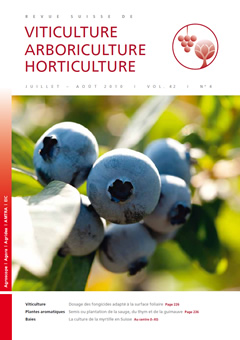
Issue 4 - July - August 2010
Abstract in open access
In viticulture, a fix hectare or hectoliter dosage of plant protection products is not suitable, because the leaf area vary considerably during the growing season. The current Swiss dosage system consists in a linear adaptation, following the phenological development of the vine. Leaf area adapted dosage is aimed at delivering exactly the amount of product requested for a given leaf area present at the time of spraying. An easy and user friendly calculation module is available on www.agrometeo.ch. Between 2005 and 2009, field trials performed at Perroy (VD) have shown that the crop adapted dosage lead to an average reduction of 20 % of the quantity of fungicides applied yearly without difference in efficacy compared to the standard dosage currently used in Switzerland. Besides decreasing the impact on the environment, crop adapted spraying allowed a cost reduction of 17 %, corresponding to a decrease of 157 CHF per hectare. Crop adapted spraying makes it possible to adapt the dose according to an objective base, in order to obtain a constant quantity of active ingredient per leaf area unit during the whole growing period of the vine.
Keywords: crop adapted spraying, grapevine, control strategies, downy mildew
E-Mail: olivier.viret@acw.admin.ch
Adress:
Abstract in open access
For organic production in mountain areas, fields of aromatic and medicinal plants are becoming more mechanized in order to reduce the workforce needs. Cultivation fields are established either by direct sowing or by planting. The effect of the cultivation technique was studied on yield and quality of thyme (Thymus vulgaris L.), sage (Salvia officinalis L.) and marshmallow (Althaea officinalis L.). For all three species, dry matter and active compounds production was hardly affected. However, sowing is preferred to planting for marshmallow because taproots are smaller and therefore easier to harvest, wash and dry. To choose the method of installation, yield and quality are not significant factors. Weed pressure, possibility of mechanization and irrigation, workforce availability and post-harvest factors are more decisive to determine the better strategy.
Keywords: Thymus vulgaris, Salvia officinalis, Althaea officinalis, dry matter, essential oil, field sowing, density planting
E-Mail: claude-alain.carron@acw.admin.ch
Adress:
Abstract in open access
The fruit producers and industrials are keen to better control the initial quality of their products and are interested to the new techniques that can permit them to characterise their fruits. The sensory analysis is the only way to measure globally different fruit quality parameters (texture, flavour, aroma) in relation to the consumer perception. However, this method is very complex and time consuming. For this reason, many attempts have been made to replace sensory analysis with relevant instrumental measurements. Above the promising methods, Visible Near Infrared Spectrosocopy was selected as this method already permitted to predict some of the physicochemical and sensory properties of fruits. Moreover this technique is fast, non-destructive and can be done in laboratory or in field as the portative equipment are already commercialised. The aim of this study is to test the capability of the Visible Near Infrared Spectroscopy to discriminate different apple or grape batches in relation to their maturity stage and to try to predict with this method their sensory quality.
Keywords: apple, grape, quality, sensory analysis, Visible Near Infrared Spectrosocopy
E-Mail: f.jourjon@groupe-esa.com
Adress: Ecole supérieure d'agriculture d'Angers ESA, F-49007 Angers Cedex 01
Abstract in open access
Four plots have been planted with homogeneous material of Pinot noir cultivar on typical soils of Chamoson area (Valais, Switzerland). Conducted from 1997 to 2000, this research allowed pointing out the influence of water nutrition on agronomical and oenological potential of Pinot noir. In a situation without water restriction, vigour was clearly higher and budburst was delayed. In the must, soluble solids content was lower in absence of water constraint, while malic acid and nitrogen contents were higher. Meanwhile, pH remained relatively constant due to higher potassium content. In fact, any situation inducing regular and moderate water restriction during ripening did led to wines with more polyphenols and more qualitative tannins, which were preferred by the panel of tasters.
Keywords: grapevine, Pinot noir, water stress, quality
E-Mail: jean-laurent.spring@acw.admin.ch
Adress:

 Download of full issue
Download of full issue
 Download article
Download article